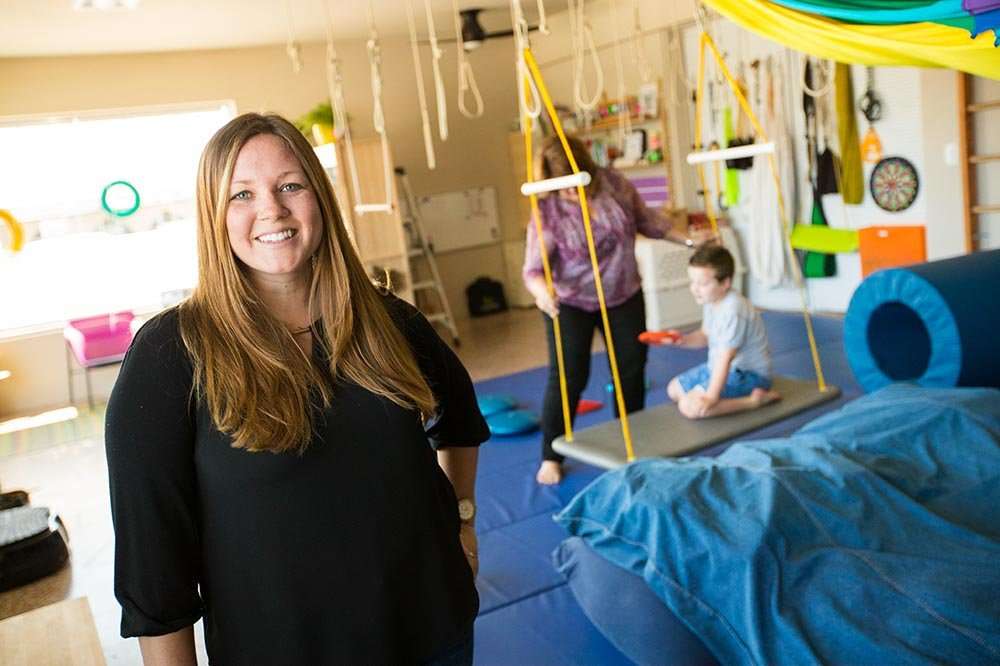
Autism spectrum disorder (ASD) is a neurodevelopmental condition characterized by impaired social communication skills, restricted and repetitive behaviors, and isolated areas of interest. Approximately one in 54 children in the United States are diagnosed with ASD, which can be recognized as early as age two but is typically detected after age four.
Early diagnosis and intervention can greatly improve outcomes for people with autism. ((Lonnie Zwaigenbaum et al., “Early Identification and Interventions for Autism Spectrum Disorder,” Pediatrics, Oct. 2015: https://pediatrics.aappublications.org/content/136/Supplement_1/S1)) Occupational therapy (OT) is a primary mode of intervention. This post explores the benefits of occupational therapy for autism, as well as the unique role that OT plays in treating ASD.
What Is Occupational Therapy?
Occupational therapy is a field of healthcare that holistically treats people who have injuries, disabilities, or other conditions, including autism. In this practice, occupational therapists (OTs) help patients develop, recover, or maintain their ability to engage in meaningful daily activities, including communicating appropriately with others.
OTs begin the process by communicating directly with the patient and family to understand the patient’s individual needs. They assess the patient’s physical, sensory, emotional, and cognitive abilities before developing reasonable goals and a treatment plan. The OT then works with the patient for several sessions or longer term, helping them make progress toward their goals.
The Role of Occupational Therapy in Treating ASD
Occupational therapists evaluate the current developmental levels of children and adults with autism, aiming to improve their ability to self-regulate emotions and participate in social interactions. ((Lisa Crabtree and Barbara Demchick, “Occupational Therapy’s Role with Autism,” American Occupational Therapy Association, 2018: https://www.aota.org/-/media/corporate/files/aboutot/professionals/whatisot/cy/fact-sheets/autism%20fact%20sheet.pdf)) Through interventions, OTs can help people with autism build on their areas of strength and overcome their limitations.
Ways Occupational Therapists Evaluate ASD
To evaluate a patient with autism, the OT may use screening tools such as an autism checklist, a sensory profile, the Childhood Autism Rating Scale (CARS), or diagnosis criteria set forth in the fifth edition of the Diagnostic and Statistical Manual of Mental Disorders (DSM-V). ((Payal Pawar, “Occupational Therapy for Autism – Assessment and Intervention,” Occupational Therapy {OT}, last updated April 23, 2017: https://occupationaltherapyot.com/occupational-therapy-autism/)) When observing the patient, an OT will consider the following skills: ((WebMD, “Benefits of Occupational Therapy for Autism,” reviewed Nov. 12, 2018: https://www.webmd.com/brain/autism/benefits-of-occupational-therapy-for-autism)), ((Crabtree, “Occupational Therapy’s Role.”))
- Social:
interactions with others, emotion regulation, behavior, desire for personal space, eye contact, aggression
- Communication:
speech, non-verbal communication
- Cognitive:
attention span, stamina
- Sensory:
responses to stimuli, sensory seeking, sensory defensiveness
- Motor
: posture, balance, manipulation of small objects
Common Occupational Therapy Interventions for Autism
After completing the evaluation, the occupational therapist works with the patient and family to develop an intervention plan and treatment goals. Occupational therapy interventions for autism may include: ((Ibid.)), ((Center for Autism Research, “Occupational Therapy for Children on the Autism Spectrum,” last updated May 29, 2020: https://www.carautismroadmap.org/the-role-of-pediatric-occupational-therapy-for-children-with-asd/))
-
Focusing on sensory integration and sensory-based strategies.
-
Emphasizing mental health and wellness.
-
Implementing emotional development and self-regulation strategies and programs.
-
Organizing peer groups, social participation, and play activities.
-
Improving self-care routines to help with daily activities such as bathing, feeding, and grooming.
-
Working on motor development.
-
Supporting an adolescent’s transition into adulthood and helping them build skills to enter the workforce.
-
Using cognitive behavioral approaches to support positive behaviors.
Benefits of Occupational Therapy for Autism
The main goal of occupational therapy for autism is to improve the patient’s quality of life. Through interventions, occupational therapists can help people with ASD gain independence and: ((Applied Behavior Analysis Programs Guide, “How Does Occupational Therapy Benefit A Child with Autism?”: https://www.appliedbehavioranalysisprograms.com/faq/how-does-occupational-therapy-benefit-a-child-with-autism/))
-
Focus on academic tasks.
-
Communicate appropriately.
-
Maintain and foster relationships.
-
Work with others to achieve a common goal or purpose.
-
Learn to delay gratification.
-
Express emotions in a healthy, productive way and regulate arousal level.
-
Become more independent and confident.
-
Feel less anxious.
How to Find an Occupational Therapist
Contacting the patient’s school or physician is a good place to start to find a qualified occupational therapist. When choosing an OT to work with a child or adult with autism, look for someone who is willing to: ((STAR Institute, “Choosing an Occupational Therapist”: https://www.spdstar.org/basic/choosing-an-occupational-therapist))
-
Conduct a comprehensive diagnostic evaluation and create written goals for treatment.
-
Offer one-on-one treatment in a sensory-rich setting.
-
Provide an intensive treatment program that encourages family members to participate.
-
Ask questions, and encourage the patient and family to do the same.
Occupational therapy helps people at all points along the autism spectrum develop the skills they need to communicate better and participate in meaningful daily activities. OT practitioners are uniquely positioned to provide treatment that can help individuals with autism succeed. Becoming an occupational therapist is a rewarding career path that can lead you to help people of all ages manage physical and cognitive disabilities and differences. If this direction interests you, check out the entry-level graduate degree programs in occupational therapy offered by the University of St. Augustine for Health Sciences.
The University of St. Augustine for Health Sciences (USAHS) offers hands-on Master of Occupational Therapy (MOT) and Doctor of Occupational Therapy (OTD) degrees. Practice with mock patients in our state-of-the-art simulation centers and learn anatomy with our high-tech tools. Prepare for clinical practice with patients across the lifespan, as well as advanced roles in research, practice leadership, and policymaking. Residential and Flex (online/weekend-focused) paths are available. We also offer an online Post-Professional Doctor of Occupational Therapy (PPOTD) program, which is designed for working clinicians and healthcare educators who need flexibility in earning their degree.

An autism diagnosis can throw a family into a tailspin. They have to adjust their expectations about that child hitting important milestones like other children. However, occupational therapists and mental health interventions are critical in managing the care of an autistic child. There are so many questions to answer, and we want to help you clear up any uncertainties you may have about autism. Let’s begin.
Frequently Asked Questions (FAQs) About Autism
Some of the FAQs about autism include:
What is Autism?
Autism, or the autism spectrum disorder (ASD), covers a variety of conditions that are characterized by difficulties with social skills, repetitive behaviors, as well as speech and nonverbal communication. According to the Centers for Disease Control (CDC), autism affects 1 in 54 children in the USA.
Autism has many subtypes and they are influenced by a combination of genetic and environmental factors. Since autism is a spectrum disorder, each person with autism has a unique set of strengths and weaknesses. How a person with autism thinks, learns, and problem-solves can range from highly-skilled to severely challenged. Some persons with ASD may need extensive support in their daily lives. However, others may need far less support, and in some instances, may live on their own.
What Factors are Associated With Autism?
Many factors are associated with insufficient brain development and the onset of autism. ASD is also associated with challenges such as Asperger’s syndrome, childhood disintegrative disorder, and an unspecified category of pervasive developmental disorder (PDD).
The development of ASD is also associated with sensory challenges, gastrointestinal (GI) disorders, seizures, and sleep disorders. Persons with ASD may also experience mental health concerns such as anxiety, depression, and attention deficit problems.
How is Autism Diagnosed?
It can be difficult to diagnose the autism spectrum disorder (ASD) as there is no medical test (like a blood test) that can detect the disorder. Therefore, doctors must examine a child’s developmental history and behavior to make a diagnosis.
The signs of autism often appear by age 2 or 3. But some associated developmental delays can occur even earlier and can be diagnosed as early as 18 months. By age 2, a diagnosis by a medical expert is quite reliable. But some children do not receive a final diagnosis until they are much older. In other cases, persons are not diagnosed until they are adolescents or adults. Unfortunately, this delay means that children with ASD may not get the early assistance that they need.
Some of the signs of ASD can include (but are not limited to):
-
Failing to respond to their name by 12 months
-
Failing to point at objects to indicate interest by 14 months
-
Not playing “pretend” games (like pretending to feed a doll) by 18 months
-
Avoiding eye contact and wanting to be alone
-
Challenges talking about their feelings
-
Difficulties understanding other people’s feelings
-
Delayed speech and language skills
-
Continuous repetition of words and phrases (echolalia)
-
Giving unrelated answers to questions
-
Getting upset because of minor changes to routine
-
Having obsessive interests
-
Flapping their hands, rocking the body, and/or spinning in circles
-
Having unusual reactions to the way things sound, smell, taste, look or feel
However, research indicates that early childhood interventions can lead to positive outcomes later in life for people with autism.
How Important is Occupational Therapy for Children With Autism?

Children with autism tend to exhibit significantly different sensory processing patterns when compared to their peers (and even other children with special educational needs). It is estimated that between 42 to 95 percent of autistic children also have sensory processing disorders. Furthermore, studies have shown that people with autism are slower to integrate sensory inputs and this makes their processing much slower. This may explain why autistic children often have meltdowns.
Autistic children do not have the right filters to screen out irrelevant information. This can lead to a meltdown, as each input builds on the other without being internally managed. This sensory overload can present itself in several ways, such as challenging behavior, withdrawal, and/or complete shutdown.
Several strategies can be applied in the home or classroom to provide the necessary sensory filters that autistic children need. Occupational therapists are useful in providing this vital intervention. Including the right filters to target each sensory system will help the child become more organized and improve their attention and performance.
What Does Occupational Therapy Look Like for Autistic Children?
Occupational therapists follow a holistic approach when developing programs. They account for the physical, social, emotional, sensory, and cognitive abilities and needs of students. Occupational therapists promote, maintain, and develop the skills that children need to be functional in home and school settings and beyond. The activities completed in occupational therapy sessions support learning, build self-esteem, self-confidence, and independence, and promote healthy social interactions.
When working with autistic children, an occupational therapist will seek to develop the skills needed for handwriting, fine motor skills, and daily living skills. However, the most pressing requirement is to assess and target each child’s sensory processing disorders. This is helpful for the child, as it removes the barriers to learning and helps them to become calmer and more focused. An occupational therapist that works with children with sensory processing disorders will often have postgraduate training in sensory integration.
Sensory integration therapy is based on the assumption that a child is either overstimulated or understimulated by their environment. Therefore this intervention aims to improve the brain’s ability to process sensory information so that the child will function better in their daily activities. Furthermore, occupational therapists often prescribe a sensory diet or lifestyle for autistic children.
What is a Sensory Diet or Lifestyle?
We unconsciously learn to combine our senses to understand our environments. Every child will have a unique set of sensory needs. Furthermore, these needs will change depending on the mood, environment, and therapeutic intervention.
Just as our bodies need the right amount of food evenly spaced throughout the day, our bodies also need the appropriate activities to keep our emotions and wellbeing at the optimal level. A sensory diet or lifestyle is a designed activity plan for each day. It serves to include sensory activities throughout a child’s daily waking hours to improve their focus, attention, performance and to keep them regulated (or in a good mood). An experienced occupational therapist will rely on their advanced training and evaluation skills to develop an effective sensory diet for each child’s unique needs.
What Issues Does a Sensory Diet Address?
The impact of a sensory diet include:
-
Help restructure a child’s nervous system over time so that they are better able to tolerate challenging sensations and situations
-
Assist a child in regulating their awareness and increasing attention span
-
Limit sensory-seeking and sensory-avoiding behaviors
-
Help a child deal with transitions with less stress
-
Improve a child’s focus and ability to ignore distractions
-
Increase the ability to process and act upon information received through the senses
An occupational therapist will recommend starting each day with a sensory circuit.
What is a Sensory Circuit?

A sensory circuit is a sensory-motor activity program that helps children get into a receptive mode for learning. Each session includes:
-
Alerting activities (like spinning, bouncing on a gym ball, skipping, and star jumps) to stimulate the central nervous system
-
Organizing activities (such as balancing on a wobble board, log rolling, and juggling) that require the brain and body to cooperate
-
Calming activities (for example, heavy muscle work and
deep pressure exercises
) to make them aware of their bodies in space and increase the body’s ability to self-regulate sensory inputs
Occupational therapy intervention improves the communication, interaction, and motor skills of most children (including those who are “hard to reach”). When children are more regulated, they experience less anxiety and that improves their ability to thrive in different environments.
Are There Other Types of Therapy Used for Autistic Children?
Other types of therapy are useful for autistic children:
Applied Behavior Analysis (ABA)
ABA is one of the most popular therapies used for children with ASD. However, ABA training is most effective if therapy begins when the child is younger than age 5 – although older children with ASD can still benefit.
ABA teaches social, motor, and verbal behaviors as well as reasoning skills. It also teaches parents and caregivers how to manage challenging behaviors. These skills are taught through observation and positive reinforcement.
A child will need extensive one-on-one therapy for an average of 25 hours each week to get the most benefit from ABA. However, this therapy can be quite expensive. ABA training is also most effective if parents and caregivers are also trained in ABA. This will help them to teach the child and constantly reinforce positive behaviors.
Relationship Development Intervention (RDI)
RDI training is a new, trademarked therapy for ASD. According to the developers of this treatment, RDI training is most effective when it begins at an early age, but older children (and even adults) can also benefit.
This approach teaches autistic children how to engage in quick thinking and have good social relationships with others. RDI training usually begins by helping children develop relationships with their parents and other family members.
The involvement of parents and caregivers is critical for the success of RDI training. They are taught how to use all opportunities as teachable moments. These moments also offer the chance for parental engagement to instill the right social skills.
Since RDI training is relatively new, there isn’t enough supporting clinical evidence of its effectiveness. But recent studies conducted by its developers show its effectiveness in treating autistic children.
Parents and caregivers of autistic children who choose RDI training will need to make significant time and financial commitments. This training involves several workshops or watching videos to learn how to provide an effective intervention program (which is also expensive). Furthermore, RDI training requires regular communication with a certified RDI program consultant that includes filming interactions with your child.
What Are Some Strategies for Parents of Autistic Children?

Parents and caregivers are at the frontline of helping their autistic children cope:
-
If the child is overwhelmed by excessive noise, offer them ear defenders or let them listen to their favorite music.
-
For a child who gets agitated by touch, limit the opportunities for them to be bumped or touched inadvertently.
-
For a child who can’t sit still for long, incorporate regular movement breaks. Also, try using a wobble cushion as seating to make it easier for them to move.
-
For the child who likes to hug, try lycra undergarments, trial rash vests, and rugby base layers. These are all cheaply available from several sports outlets.
-
If a child struggles with black print on a white background, then change to a buff color. Also, use larger and simpler fonts.
-
For a child easily overwhelmed by smells, consider using a sweatband with a drop of oil, shampoo, or any item that they like. They can also take along the sweatband to help them mask any uncomfortable smells.
-
To engage picky eaters and children who have limited diets encourage food play. But don’t pressure children to eat or do so at mealtimes. The objective is to reduce the fear of food.
-
Create a quiet, calming room or space. Add some comforting items like a popup tent, or a blanket over a table or under a cabin bed. Also, add beanbags, sensory toys, and other items.
-
For the child who likes to chew, give them crunchy breadsticks, carrot sticks, or other chewy but healthy foods.
-
In the case of children who dislike brushing their teeth, try a vibrating toothbrush and unflavored toothpaste. This will make the event more interesting for them.
How Do I Find a Speech Therapy Program for Autism?
We have explored how occupational therapists and mental health interventions can assist autistic children. Does your child need speech therapy? Are you looking for an occupational therapist in Sheldon, CT? We have a team of experts who can help you and your family live fully in the face of an ASD diagnosis. Contact us at Moving With Hope to access effective speech therapy, and also the comprehensive support that you need.





